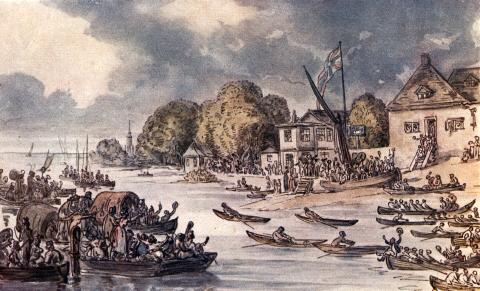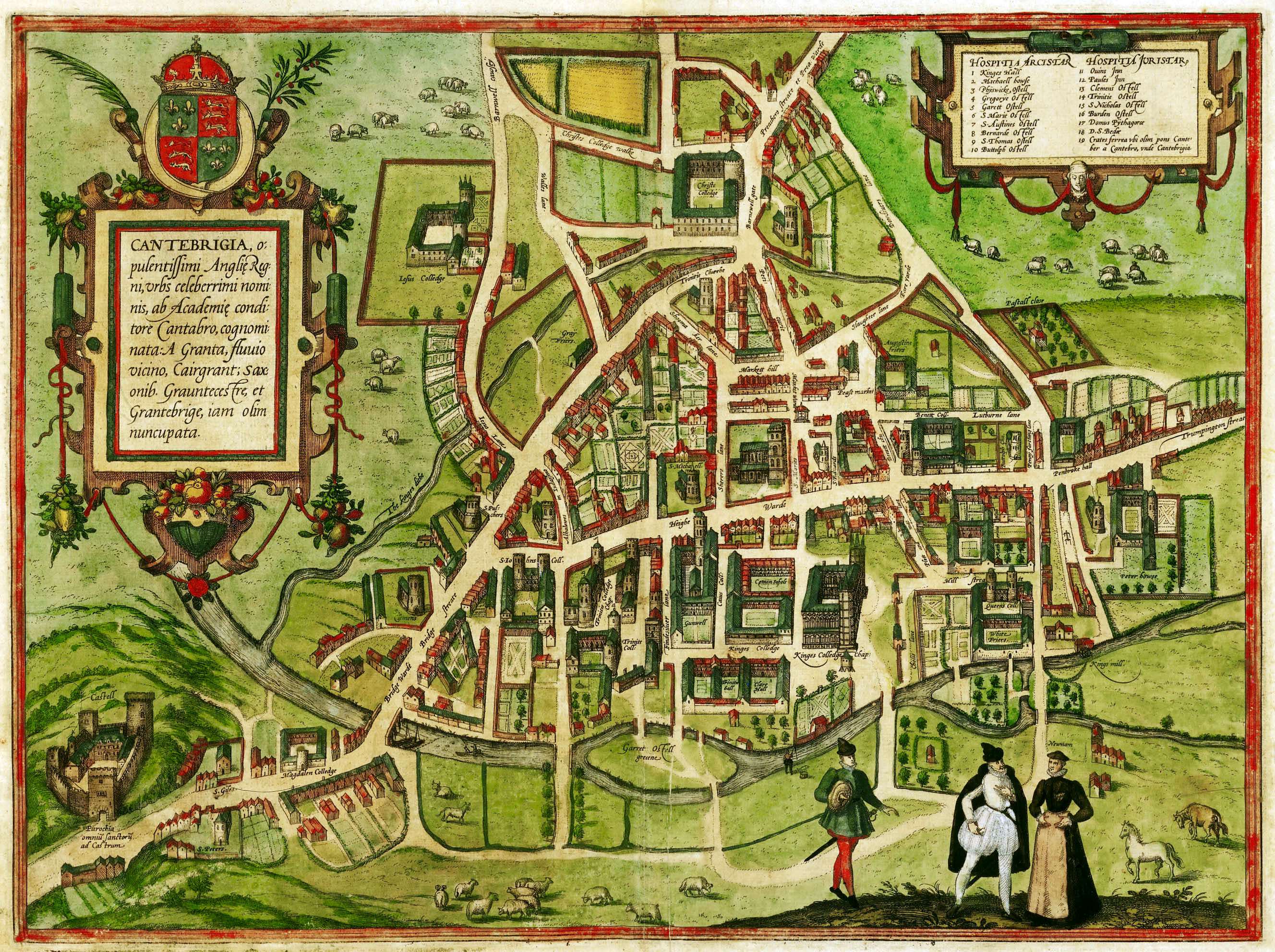|
Wherry
A wherry is a type of boat that was traditionally used for carrying cargo or passengers on rivers and canals in England, and is particularly associated with the River Thames and the River Cam. They were also used on the Broadland rivers of Norfolk and Suffolk. Regional usage in Great Britain London passenger wherries evolved into the Thames skiff, a gentleman's rowing boat. Wherries were clinker-built with long overhanging bows so that patrons could step ashore dryshod before landing stages were built along the river. It is the long angled bow that distinguishes the wherry and skiff from the gig and cutter which have steeper bows following the rise of the Royal Navy, and the building of landing stages. The use of wherries on the River Cam in Cambridge was common and is described by Daniel Defoe in his journey through England. The use of wherries on the River Cam preceded the popularity of punting by Cambridge University students. By the late 18th century, a name was giv ... [...More Info...] [...Related Items...] OR: [Wikipedia] [Google] [Baidu] |
Watermen
A waterman is a river worker who transfers passengers across and along city centre rivers and estuaries in the United Kingdom and its colonies. Most notable are those on the River Thames and River Medway in England, but other rivers such as the River Tyne and River Dee, Wales, also had their watermen who formed guilds in medieval times. Waterman can also be a person who navigates a boat carrying passengers. These boats were often rowing boat or boats with sails. Over the years watermen acquired additional skills such as local pilotage, mooring vessels at berths, jetties, buoys, and docks, and acting as helmsman aboard large vessels. Watermen in the United Kingdom: 1197 to 1859 Watermen or wherrymen were an essential part of early London. Using a small boat called a wherry or skiff they would ferry passengers along and across the river. With bad rural roads and narrow congested city streets, the Thames was the most convenient highway in the region. Until the mid-18th century L ... [...More Info...] [...Related Items...] OR: [Wikipedia] [Google] [Baidu] |
Thames Skiff
A Thames skiff is a traditional River Thames wooden rowing boat used for skiffing. These boats evolved from Thames wherry, wherries in the Victorian era to meet a passion for river exploration and leisure outings on the water. Construction The Thames skiff owes its origins to the Clinker (boat building), clinker boat building technique, of over-lapping timber planking, that's known to have existed in the region from before the 6th century Anglo-Saxons, Anglo-Saxon Snape Anglo-Saxon Cemetery#The Ship Burial, Snape and Sutton Hoo ship burials. Many of the terms used for parts of the skiff are of Germanic origin – "Wiktionary:thole, tholes", "thwarts", and "Wiktionary:sax, sax". Planks on either side of a wooden keel are laid down following the outline of a sham (temporary pattern) placed across the keel. The planks are nailed in place and then a transverse strengthening framework of ribs is added. Oars (or blades) are held in place by wooden thole pins at the side of the boat r ... [...More Info...] [...Related Items...] OR: [Wikipedia] [Google] [Baidu] |
Cambridge
Cambridge ( ) is a List of cities in the United Kingdom, city and non-metropolitan district in the county of Cambridgeshire, England. It is the county town of Cambridgeshire and is located on the River Cam, north of London. As of the 2021 United Kingdom census, the population of the City of Cambridge was 145,700; the population of the wider built-up area (which extends outside the city council area) was 181,137. (2021 census) There is archaeological evidence of settlement in the area as early as the Bronze Age, and Cambridge became an important trading centre during the Roman Britain, Roman and Viking eras. The first Town charter#Municipal charters, town charters were granted in the 12th century, although modern city status was not officially conferred until 1951. The city is well known as the home of the University of Cambridge, which was founded in 1209 and consistently ranks among the best universities in the world. The buildings of the university include King's College Chap ... [...More Info...] [...Related Items...] OR: [Wikipedia] [Google] [Baidu] |
Elizabethan Era
The Elizabethan era is the epoch in the Tudor period of the history of England during the reign of Queen Elizabeth I (1558–1603). Historians often depict it as the golden age in English history. The Roman symbol of Britannia (a female personification of Great Britain) was revived in 1572, and often thereafter, to mark the Elizabethan age as a renaissance that inspired national pride through classical ideals, international expansion, and naval triumph over Spain. This "golden age" represented the apogee of the English Renaissance and saw the flowering of poetry, music, and literature. The era is most famous for its theatre, as William Shakespeare and many others composed plays that broke free of England's past style of theatre. It was an age of exploration and expansion abroad, while back at home, the Protestant Reformation became more acceptable to the people, most certainly after the Spanish Armada was repelled. It was also the end of the period when England was a sep ... [...More Info...] [...Related Items...] OR: [Wikipedia] [Google] [Baidu] |
Water Taxi
A water taxi or a water bus is a boat used to provide public transport, public or private transport, usually, but not always, in an Urban area, urban environment. Service may be scheduled with multiple stops, operating in a similar manner to a bus, or on demand to many locations, operating in a similar manner to a taxicab, taxi. A boat service shuttling between two points would normally be described as a ferry rather than a water bus or taxi. The term ''water taxi'' is usually confined to a boat operating on demand, and ''water bus'' to a boat operating on a schedule. In North American usage, the terms are roughly synonymous. The earliest water taxi service was recorded as operating around the area that became Manchester, England. Locations Cities and other places operating water buses and/or taxis include: On demand water taxis are also commonly found in marinas, harbours and cottage areas, providing access to boats and waterfront properties that are not dire ... [...More Info...] [...Related Items...] OR: [Wikipedia] [Google] [Baidu] |
London
London is the Capital city, capital and List of urban areas in the United Kingdom, largest city of both England and the United Kingdom, with a population of in . London metropolitan area, Its wider metropolitan area is the largest in Western Europe, with a population of 14.9 million. London stands on the River Thames in southeast England, at the head of a tidal estuary down to the North Sea, and has been a major settlement for nearly 2,000 years. Its ancient core and financial centre, the City of London, was founded by the Roman Empire, Romans as Londinium and has retained its medieval boundaries. The City of Westminster, to the west of the City of London, has been the centuries-long host of Government of the United Kingdom, the national government and Parliament of the United Kingdom, parliament. London grew rapidly 19th-century London, in the 19th century, becoming the world's List of largest cities throughout history, largest city at the time. Since the 19th cen ... [...More Info...] [...Related Items...] OR: [Wikipedia] [Google] [Baidu] |
Tideway
The Tideway is the part of the River Thames in England which is subject to tides. This stretch of water is downstream from Teddington Lock. The Tideway comprises the upper Thames Estuary including the Pool of London. Tidal activity Depending on the time of year, the river tide rises and falls twice a day by up to 7 m (24 ft). Because the tide goes against the outflow of fresh water from the Thames Basin, London Bridge is used as the basis for published tide tables giving the times of high tide. High tide reaches Putney about 30 minutes later. Low-lying banks of London are naturally vulnerable to flooding by storm surges. The threat has increased mostly due to the rise in sea levels caused by climate change, but some is also due to the extremely slow 'tilting' of Britain (up in the north and down in the south) due to post-glacial rebound. The city and state have erected defensive barriers, including the Thames Barrier, which was constructed across the Thames at Wo ... [...More Info...] [...Related Items...] OR: [Wikipedia] [Google] [Baidu] |
Book Of Ezekiel
The Book of Ezekiel is the third of the Nevi'im#Latter Prophets, Latter Prophets in the Hebrew Bible, Tanakh (Hebrew Bible) and one of the Major Prophets, major prophetic books in the Christian Bible, where it follows Book of Isaiah, Isaiah and book of Jeremiah, Jeremiah. According to the book itself, it records six visions of the Biblical prophet, prophet Ezekiel, exiled in Babylon, during the 22 years from 593 to 571 BC. It is the product of a long and complex history and does not necessarily preserve the words of the prophet. The visions and the book are structured around three themes: (1) judgment on Israel (chapters 1–24); (2) judgment on the nations (chapters 25–32); and (3) future blessings for Israel (chapters 33–48). Its themes include the concepts of the Divine presence#Judaism, presence of God, purity, Israel as a divine community, and individual responsibility to God. Its later influence has included the development of Mysticism, mystical and apocalyptic tr ... [...More Info...] [...Related Items...] OR: [Wikipedia] [Google] [Baidu] |
Coverdale Bible
The Coverdale Bible, compiled by Myles Coverdale and published in 1535, was the first complete Modern English translation of the Bible (not just the Old, or New Testament), and the first complete printed translation into English (cf. Wycliffe's Bible in manuscript). The later editions (folio and quarto) published in 1537 were the first complete Bibles printed in England. The 1537 folio edition carried the royal licence and was therefore the first officially approved Bible translation in English. The Psalter from the Coverdale Bible was included in the Great Bible of 1540 and the Anglican ''Book of Common Prayer'' beginning in 1662, and in all editions of the U.S. Episcopal Church ''Book of Common Prayer'' until 1979. History The place of publication of the 1535 edition was long disputed. The printer was assumed to be either Froschover in Zürich or Cervicornus and Soter (in Cologne or Marburg). Since the discovery of Guido Latré, in 1997, the printer has been identified as ... [...More Info...] [...Related Items...] OR: [Wikipedia] [Google] [Baidu] |
The Galloway News
''The'' is a grammatical article in English, denoting nouns that are already or about to be mentioned, under discussion, implied or otherwise presumed familiar to listeners, readers, or speakers. It is the definite article in English. ''The'' is the most frequently used word in the English language; studies and analyses of texts have found it to account for seven percent of all printed English-language words. It is derived from gendered articles in Old English which combined in Middle English and now has a single form used with nouns of any gender. The word can be used with both singular and plural nouns, and with a noun that starts with any letter. This is different from many other languages, which have different forms of the definite article for different genders or numbers. Pronunciation In most dialects, "the" is pronounced as (with the voiced dental fricative followed by a schwa) when followed by a consonant sound, and as (homophone of the archaic pronoun ''thee' ... [...More Info...] [...Related Items...] OR: [Wikipedia] [Google] [Baidu] |






